

... Steve DeFrisco
By Scott Stilphen
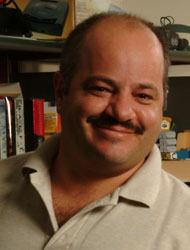
Steve got his start in game design at Imagic, making some truly magical games, such as Tropical Trouble and Wing War. After the industry reset itself, he designed a trio of Atari VCS games in that system's twilight, and then worked at Digital Pictures on some of the first full-motion video games for the Sega CD. He's currently a senior programmer at Volition, working on titles for both the XBOX 360 and PS3. And if that's not enough, he's also a full-fledged actor!
DP: What’s your educational background?
Steve DeFrisco: I went to San Jose State University from 1978 to 1981, major in Industrial Design, minor in computer applications. They didn’t have much of a software engineering program there at the time, mostly hardware. I transferred to U.C. Santa Cruz for 2 quarters, majoring in Computer Science.
DP: What inspired you to go into game design?
Steve DeFrisco: Playing board games has always been a big thing for my family. When I get together with my family at the holidays we still play board games. My parents got us one of the earliest video game systems. I think it was by Magnavox – you had to put clear plastic overlays on the screen, and there was just one or two moveable white squares on the screen. After that we had an Atari 2600 – who didn’t? I loved playing Asteroids so much, I went to Wyle Distributing, bought the same type of buttons on the arcade machine and built a controller box (shown below) so I could play it the same way as the arcade instead of the joystick.

DP: Were there any programmers or games that inspired you?
Steve DeFrisco: Anything and everything.
DP: Did you work for anyone prior to starting at Imagic?
Steve DeFrisco: Aside from being a busboy, pizza cook, and bank teller, no.
I started at Imagic as an intern – they called us “baby programmers”. We were the first group of interns at Imagic – Doug, Alan, Patrick, Marvin and I.
DP: How did you hear about Imagic? When did you start working there; and when did you leave? Do you recall who you interviewed with?
Steve DeFrisco: I heard about Imagic through Brian Dougherty, one of the founders. My older brother married Brian’s sister, and when Imagic decided to have an intern program, Brian contacted me. I had an Atari 800 at the time, and I wrote a game called Save the Schmoo, which was a mix of Basic and 6502 Assembly Language, and brought it to the interview. I started there in the summer of 1982, and stayed there until it closed in 1985.
DP: What was the development process like?
Steve DeFrisco:
I was so excited to be working on a video game – it was a booming industry when
I joined. Demon Attack had just come out and Imagic was the company to be
working for. Rob Fulop, Dennis Koble, Bob Smith, Rick Levine, Brian Dougherty,
Mike Green, Pat Ransil – these guys were the cream of the crop. And I got to
know them. It was very cool. Our art staff was great too – Michael Becker, Willy
Aguilar and Karen Elliott.
We created a concept, each engineer came in with ideas. We hashed them out a bit
and started working. There was a learning curve as we all came up to speed on
the Mattel Intellivision – we weren’t allowed to work on the Atari 2600 as it
was considered too hard for us newbies. We helped each other with ideas and
squashing bugs. The marketing folks did some focus testing on the ideas, but we
were pretty much allowed to run with it.
We all spent way too many hours at work – and ate out at restaurants too often,
I’ll tell you that. I think I gained 30 lbs. that first year!
DP: How did you come to work for Nolan Bushnell at Axlon?
Steve DeFrisco: One of the guys from Imagic, Dave Boisvert, went to work at Axlon after Imagic closed. I interviewed with Nolan and Tom Zito (later president of Digital Pictures).
When I started there, Axlon was doing electronic toys. This
was after the Apple II and Atari 800 accessories and after the robots. Axlon had
just come off the Petster line (electronic cats), among other toys. My first job
was to take the code written for the cat Petster and change the “meow” to an
“oink” sound so they could change the skin into a pig. Later we prototyped all
sorts of hand-held games, and then Atari came to Nolan looking to revive
interest in the Atari 2600 with games “Designed by the Creator of the 2600.” We
hired Todd Frye as a contractor (one of the original Atari 2600 programmers),
and John Viffian, Pete Mokris, and I started working on some new products. Some of them were
initially Nolan’s ideas, but we fleshed them out into games and programmed them.
I honestly don't remember what Pete worked on. He was more of a hardware/audio
engineer, but he helped us out.
DP: Tell us about each of the games you worked on, starting with Tropical Trouble - Intellivision
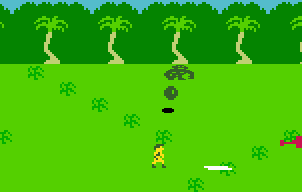
Steve DeFrisco: Tropical Trouble was sort of a sequel to Wendell Brown’s game “Beauty and The Beast”. The same basic premise – the Beast steals your girl and you’ve got to get her back. This was my first game, and the screen you have a shot of here was the most difficult part - keeping track of the player, the plants, the monkey and his coconuts, the position of the beast (you see the girl’s legs on the right side of the screen) and the white hankie she drops for you to pick up.
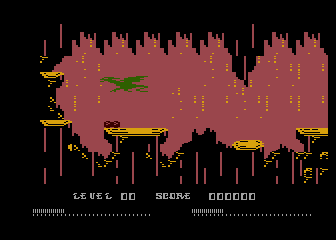
DP: Wing War – Atari 400/800. This was never released, correct? Do you recall why?
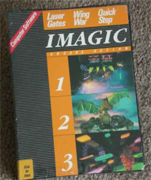
Steve DeFrisco: Alan Smith wrote a version for the Colecovision, and I wrote the Atari 800 version. This was just after the videogame business went bust when Atari announced it’s big loss. The Atari 800 version was originally a cartridge, but then was combined with Laser Gates and Quick Step, as Imagic 1-2-3 on a floppy disc. I’ve included a photo of the packaging. I don’t know if it was ever actually sold.
DP: Is the basic game premise the same as the 2600 version, of flying around and collecting crystals in a specific order to unlock super crystals?
Steve DeFrisco: Yes, it is.
DP: There's a few Imagic titles that were mentioned for the Intellivision but never released, such as Moonsweeper and Wing War. Do you know who the programmers were for those?
Steve DeFrisco: I don't think that either of those were ever worked on for the Intellivision.

DP: Did H.E.R.O. designer John Van Ryzin have any input when it came time to port the game to the Atari 800?
Steve DeFrisco: I was given a copy of the game on the 2600, and I think a printout of the assembly code, but I never spoke with John.
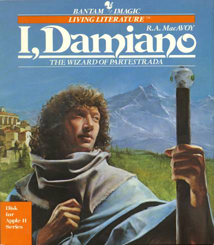
DP: I, Damiano – Apple II
Steve DeFrisco: Mark Klein wrote the IBM version of this while I wrote the Apple II version. The Author of the Damiano series, R.A. MacAvoy, came into the office one day so that our writer, Peter Golden, could discuss it with her. She was – eccentric. Mark and I shared all of the data and some code. The artwork of the map inside the box was created by my housemate at the time, Bob Pauley, who is a Production Designer at Pixar.
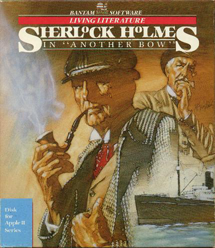
DP: Sherlock Holmes
– Apple II
Was this “Another Bow” or “Under the Boardwalk”?
Steve DeFrisco: I believe it was “Another Bow”, as we referred to it as Sherlock Holmes II. Mark Klein and I worked together on this title as well – Mark did the IBM version. We shared data and some code.
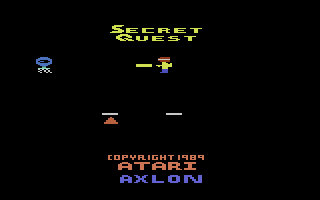
Steve DeFrisco: For Secret Quest, we wanted to create a large adventure-style game with lots of locations. In order to do that, we needed a “save game” type mechanism. I hired my brother, Chris, a great illustrator, to create the artwork, including a bunch of symbols which the player could write down and re-enter to save the game state.
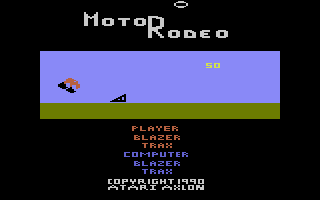
Steve DeFrisco: Motorodeo had a larger scope than it ended up having. We originally wanted to do a top-down view for driving through a mud bog, with the player correcting the steering to keep the truck facing forward. It was just too difficult to create a decent graphic on the 2600.

Steve DeFrisco: Klax - John Skrutch and Julie Wade were the producers at Atari when we were doing these games at Axlon. After I left Axlon, they offered me the contract for Klax on the 2600. It turned out to be the last contract for an Atari 2600 game in America. I was given the “C” code for the arcade version, which made it play very much like the original. They released it in Europe, but not here in America. The only copy I have is the European version. Modern TV’s won’t sync to the 50Hz vertical blank, so it rolls whenever I try to play it.

DP: You also worked with Nolan at Vent, Inc. From what we know of that company, they mostly dealt with hardware for the Macintosh, but we know of at least one game that both your and Nolan are credited with – Styxx and Bones. Can you tell us more about the company and the game(s) you did there. Was S&B another Secret Quest-like project (with you doing most of the work)?
Steve DeFrisco: Vent did create some hardware for the Macintosh, and I helped with some software. Nolan wanted a game to show at a conference that was coming up. He hired me to write Styxx and Bones. It was designed to appeal to Tetris fans as well as Pipes fans. We designed it together. Scott Eckerman did the artwork on that product.
 DP: When did you start
at Digital Pictures?
DP: When did you start
at Digital Pictures?
Steve DeFrisco: In the summer of 1993.
DP: We have you doing Prize Fighter (with Kevin Welsh and Mark Klein), Slam City with Scottie Pippen (with Kevin) and Maximum Surge. Were these the only 3 games you did there?
Steve DeFrisco: The first game I worked on there was called “Citizen X”, for the SEGA CD, which was never released.

DP: Where did you work after Digital Pictures?
Steve DeFrisco:
I worked for Planetweb, Inc., which created a web browser that was shipped with
the SEGA Saturn and Dreamcast, as well as being ported to many non-video game
platforms, such as DVD players and videophones.
I also worked at Sony Computer Entertainment of America in Foster City. I worked
in the R&D Department, and sorry, but I can’t talk about that work :).
DP: When did you start at Volition? I understand you can’t talk about any current projects there, but are there any released products that you were involved with?
Steve DeFrisco: I joined Volition in August of 2006, just after Saint’s Row was released. I have not worked on any released Volition products.
DP: In regards to your earlier games at Imagic and Axlon, did you work with any graphics or sound artists? If so, do you recall who helped with what?
Steve DeFrisco: Imagic had full-time artists – Michael Becker, Willy Aguilar and Karen Elliot. Michael recently left Electronic Arts, Willy is still there, and I’ve lost track of Karen. We were pretty much on our own as far as sounds went – the sounds weren’t too complicated then, anyway.
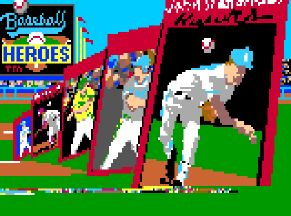 At Axlon, I hired my brother Chris to do some artwork for Secret Quest, and my
friend Bob Pauley for Baseball Heroes (for
the Lynx). I did the audio for the Atari 2600
titles, and had some help from my ex-wife Mirinia for Baseball Heroes audio.
At Axlon, I hired my brother Chris to do some artwork for Secret Quest, and my
friend Bob Pauley for Baseball Heroes (for
the Lynx). I did the audio for the Atari 2600
titles, and had some help from my ex-wife Mirinia for Baseball Heroes audio.
DP: Did you work for Atari when you did Baseball Heroes, or were you an outside contractor?
Steve DeFrisco: I was an outside contractor. I have never worked as an employee of Atari. Bob Pauley did the game artwork for this title as well. My ex-wife did the audio and music. This was the only Lynx title I worked on.
DP: With your game(s), were there any features you would have liked to added, or any known bugs or glitches that gave you trouble (or never got resolved)?
Steve DeFrisco:
In Tropical Trouble, you are running left to right, and when you hit the left
edge of the screen you “lose” a life. During testing, one of the testers jumped
off the left side of the screen and the variable keeping track of his position
wrapped around to the right side, which meant they had completed the level. That
was a surprise. It was fixed, of course.
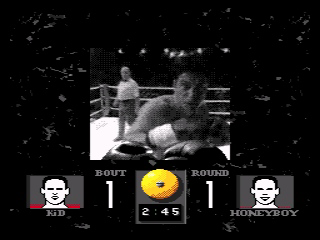 In Prize Fighter, there was a bug that would happen occasionally, where the
round would never finish. The Digital Pictures games were a series of
interleaved video clips with sprites placed over them. Prize Fighter is a
first-person boxing game where cut-away clips are shown for when you connect a
punch. Well, somewhere, in one of the cut-away clips, there was a miss-count on
the number of frames, and the round would never end. That bug took two
excruciating weeks to fix.
In Prize Fighter, there was a bug that would happen occasionally, where the
round would never finish. The Digital Pictures games were a series of
interleaved video clips with sprites placed over them. Prize Fighter is a
first-person boxing game where cut-away clips are shown for when you connect a
punch. Well, somewhere, in one of the cut-away clips, there was a miss-count on
the number of frames, and the round would never end. That bug took two
excruciating weeks to fix.
In Baseball Heroes, on a two-player game, you can only bring in a relief pitcher
between innings. There was a bug where the two Lynx units would get out of sync,
and they would both put up a message “Waiting For Other Player.” I worked on
that one bug for probably a month. The project needed to be finished, so we
decided to disallow changing pitchers. The testers hated getting that message so
much that they bought me a shirt that said “Waiting For Other Player.”
DP: Do you remember what early or tentative titles your other games had (if any)?
Steve DeFrisco:
I wanted to do an educational game based on the PBS Series “Connections”, which
I found fascinating.
I also had started on a food-chain educational game, from bacteria up through
plant and meat eaters. The idea was to work your way up the food chain, learning
new skills for each organism.
DP: Do you recall anything about the unreleased Axlon title, The Adventures of Max (by John Viffian)? You once described it as “a game where the player, Max, was to fall into deep holes and fight his way through caverns and caves back to the surface”. There also a magazine article where Nolan mentions playing a prototype of it.
Steve DeFrisco: This was one of the “Designed by Nolan” games, which was never finished. It was to be set in Medieval times, the player is a knight with a sword. That’s pretty much all we had. John moved on to another company and the game was never finished. The opening sequence of the character running and jumping into the hole, and falling to the bottom worked, but that’s it.
DP: There was an interview with Nolan Bushnell (in an issue of "Atarian" magazine) where he mentions it was about a polar bear whose objective is to descend into a pit, steal a ruby, and get back out. Are you thinking of a different game, or did the concept change at some point?
Steve DeFrisco: Game concepts change all the time. I'm not sure which came first, but I do remember both versions being discussed.
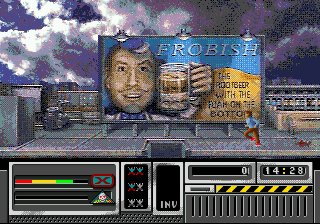
DP: Were there any games or projects that you worked on that ultimately never got released or even finished?
Steve DeFrisco:
At Imagic, I wrote a Mattel Intellivision version of Bob Smith’s Atari 2600
Shootin' Gallery. It was finished, but not released.
For a short time I worked for Hipposoft on a free-form database that was never
finished, called Hippo Simple.
At Axlon, we created many prototypes of hand-held button and led games that were
never produced.
At Digital Pictures, Citizen X was finished, but never released.
DP: Besides the ones in Tropical Trouble, are there any Easter eggs in any of your other titles? Do you recall any fellow co-workers that did?
Steve DeFrisco: I believe I put my initials in MotoRodeo and Secret Quest, but I can’t remember how to get them to show up!
DP: If you had a chance to redo any of your games, what would you change (if anything)?
Steve DeFrisco: That’s a tough question. They were all the best I could do at the time for the systems I was working on. I guess I would have liked to fix the relief pitcher problem in Baseball Heroes, but that’s about it.
DP: Did you ever attend any industry shows, such as CES or Toy Fair? Have you ever attended, or do you have plans to attend a retro gaming show such as Classic Gaming Expo?
Steve DeFrisco: I went to 2 or 3 CES Shows with Imagic, 1 or two for Digital Pictures, an ACM (American Coin Manufacturers) exhibit for Axlon, and the 2006 E3 for Sony. I’ve thought about attending the Classic Gaming Expo, but I’ve always been too busy with family life. Now that I’m divorced, I may find the time to attend.
DP: What were some of your experiences working for Imagic, Axlon, and Digital Pictures? Any stories or anecdotes from those days that you recall?
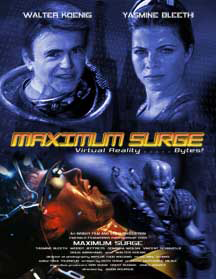 Steve DeFrisco:
Imagic was a lot of fun. Many of the employees did things outside of the office
together – going to movies, white water rafting trips, etc.. They really tried
to foster a fun environment, without competition for projects.
Steve DeFrisco:
Imagic was a lot of fun. Many of the employees did things outside of the office
together – going to movies, white water rafting trips, etc.. They really tried
to foster a fun environment, without competition for projects.
Axlon was definitely a seat-of-the-pants operation. It regularly felt as though
we would be shutting the doors any minute. Nolan had some good ideas, but
without the money and the staff that he had at Atari. So, many things were
shelved because Nolan wanted us to move on to the “next” thing.
Digital Pictures was exciting at first – we got our hands on unreleased hardware
from Sony and SEGA, and I am also an actor, so working on video based titles was
very intriguing. The hours were flexible and we working in very nice buildings
with private offices. But the hours were absolutely killer. We completed tiles
in a less than one year cycle, which means we regularly worked 60 hour weeks and
put in 6-8 weeks of 100 hours to finish the projects.
After Digital Pictures closed, the footage was sold off to a movie company, and
they created a movie based on the video clips being part of a “virtual game”
system. So, some footage from Corpse Killer, Prize Fighter, Supreme Warrior, and
Maximum Surge ended up in the movie called “Game Over.” (Ed: Also known as the
Maximum Surge Movie -
http://www.imdb.com/title/tt0382178/).
DP: I also noticed from
your resume that you did some voice acting/directing for Leather Goddesses II.
I'm surprised you didn't do some while at Digital Pictures, with the emergence
of live-action footage games. Did you do any work on the Hasbro/Nemo system (the
precursor to the Sega CD)? I know that some of DP's first games (Sewer Shark,
Night Trap) were originally designed for that hardware.
Steve DeFrisco:
The CEO (Tom Zito) was adamantly against anyone doing any voice or acting work
for any games. His attitude was that my time was far more valuable to the
company as a programmer than as an actor. What he failed to understand was that
giving anyone a different input to the product would only increase their
involvement, making them want to work harder on the game. However, for Night
Trap, Kevin Welsh needed an extra shot of one of the beasts lumbering across the
screen. The original footage was created ten years before, for the Hasbro/Nemo
system. So, anything missing would have to be created. He shot me in costume at
the office to try and show Tom that it could be done quickly and cheaply, and
wouldn't deter me from my programming work. It didn't convince Tom, but I am in
the opening sequence.
DP: With each company, what were the hours in your department? Was your schedule fixed (i.e. 9 to 5) or could you basically come and go as you pleased?
Steve DeFrisco:
Imagic was totally open as far as hours went. As long as you were there for
scheduled meetings, you could be a nocturnal animal if you wanted to be.
Axlon was fairly 9 to 5, but with the pressure to get things done, we worked a
lot of late hours.
Digital Pictures was fairly open, just be there for meetings. But the schedules
were way too short (by at least ˝), and many people got burned out. Me included.
DP: Do you still own any of your games for these systems, either as a keepsake, or to show friends or family?
Steve DeFrisco: Yes, I have copies of most of the games. I own an Atari 2600 and a Mattel Intellivision. Someday I hope to get a Sega CD, but I expect that an emulator will pop up for the PC before long.
DP: Do you still have a copy of Shootin' Gallery, or possibly Adventures of Max (or even Save the Schmoo) by any chance?
Steve DeFrisco: Well, I may have a copy of Save The Schmoo somewhere, but I doubt it very much. I definitely do not have copied of Shootin' Gallery or Adventures of Max.
DP: Which of your titles are your favorite, and what types of games in general?
Steve DeFrisco:
I have a fondness for Tropical Trouble, it being my first game. I got a fan
letter from a boy from Long Island, New York. He loved the game, and encouraged
me to write more. I was born in Brooklyn and we lived on Long Island when I was
young, so, it means something special to me. Sounds pretty sappy, but there you
go.
I like driving and flying games, and RPGs. For the last few years (until last
year) I was part of a weekly tabletop D&D group, and I’ve been Dungeon Master
for friends and for my kids.
I play some of the newer games just to get a taste of them, but I tend to get
nauseous playing first-person shooters. I am constantly impressed by the
advances in graphics, sound, and overall “mood” of the newer games.
DP: Of all the various platforms you’ve worked with, which one(s) is your most/least favorite?
Steve DeFrisco: The 2600 has a special place on my favorite list because it is tricky, and if you can do something nobody else has done, you really stand out. Your code literally races the video beam down the screen. It’s pretty exciting.
DP: Have you stayed in touch with any of your former co-workers?
Steve DeFrisco: I occasionally trade emails with some of my old co-workers, but we’re pretty spread out these days.
DP: What are your thoughts on how the industry has evolved?
Steve DeFrisco: I think the spending has gotten out of hand, considering the play-time vs. cost of creation. For main-stream games (not casual gaming, which I think is in line with the older style games), the marketing and creation cost to have an “A list” title is so high as to be silly. And since the emphasis has been on visuals and audio more than game play, they don’t always live up to the “fun factor” of even some of the earliest Atari 2600 games. Game play must be king!
DP: What was the easiest/hardest part of designing each of the games you’ve worked on?
Steve DeFrisco: Wow. That's a big question... I'll give you what I can remember.
Easiest: The easiest part of any game is the concept and initial work. It's
probably because it's so exciting to be creating something new.
Hardest: It's always the doldrums at the end of the project. All of the features
are in, and you are just trying to clean up all the bugs and tweak the code to
be the best playable experience for a large range of player ability. It's slow,
monotonous work. Besides that-
Tropical Trouble: The function that handles the character movement across the
various stages. It deals with the player movement, the obstacles, jumping,
hankies, things thrown at you, and getting hit at the left edge of the screen.
Now, a more seasoned programmer, I would have done it differently...
Wing War: Atari 800. The biggest issue was that we wanted as large a dragon as
we could get on screen. We gave up details for size.
Secret Quest: Data size issues - fitting the code into the ROM. And the "code"
creation and entry so players could save the game between sessions without any
storage medium.
Motorodeo: I had to drop the overhead view and a few other feature ideas because
they proved impossible to implement.
Baseball Heroes: The communication between multiple Lynx units turned into a big
issue and I had to drop a feature to get the game released.
Prize Fighter: Creating the different sequences and interleaving the cutaway
scenes when hits are made.
| GAMEOLOGY |
| GAME | SYSTEM | COMPANY | STATUS |
| Tropical Trouble | Intellivision | Imagic | released |
| Shootin' Gallery | Intellivision | Imagic | unreleased |
| I, Damiano | Apple II | Imagic | released |
| Sherlock Holmes: Another Bow | Apple II | Imagic | released |
| Save the Schmoo | Atari 400/800 | homebrew | unreleased |
| Wing War | Atari 400/800 | Imagic | released |
| H.E.R.O. | Atari 400/800, 5200 | Activision/Berkeley Softworks | released |
| Secret Quest | Atari VCS/2600 | Atari/Axlon (DeFrisco Entertainment) | released |
| MotoRodeo | Atari VCS/2600 | Atari/Axlon (DeFrisco Entertainment) | released |
| Klax | Atari VCS/2600 | Atari/Axlon (DeFrisco Entertainment) | released |
| Citizen X | Sega CD | Digital Pictures | unreleased |
| Prize Fighter | Sega CD | Digital Pictures | released |
| Slam City with Scottie Pippen | 32X, Sega CD | Digital Pictures | released |
| Maximum Surge | Saturn | Digital Pictures | released |
| Baseball Heroes | Lynx | Atari (DeFrisco Entertainment) | released |
| Styxx and Bones | Mac Plus | Vent Inc. (DeFrisco Entertainment) | released |
| web browser | Dreamcast | Planetweb | released |